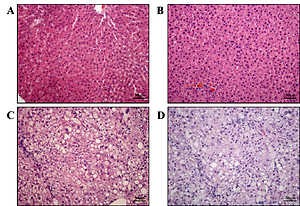Current issue
Archive
Manuscripts accepted
About the Journal
Editorial office
Editorial board
Section Editors
Abstracting and indexing
Subscription
Contact
Ethical standards and procedures
Most read articles
Instructions for authors
Article Processing Charge (APC)
Regulations of paying article processing charge (APC)
HEPATOLOGY / EXPERIMENTAL RESEARCH
Evaluation for CpG island methylation of FASN and SREBP promoter in Mongolian gerbil NAFLD model
1
College of Animal Sciences, Zhejiang University, Zhejiang, China
2
Hangzhou Medical College, Hangzhou, China
Submission date: 2019-09-09
Final revision date: 2020-03-21
Acceptance date: 2020-04-01
Online publication date: 2021-04-05
KEYWORDS
TOPICS
ABSTRACT
Introduction:
Methylation of the CpG island in the promoter and its nearby area is one of the most important ways to inhibit gene expression. The aim of this study was to examine the potential relationship between CpG island methylation for fatty acid synthase (FASN) and sterol regulatory element-binding protein 1 (SREBP-1).
Material and methods:
Ten newborn gerbil pups formed the NB group, 10 adult gerbils with a normal diet formed the control group, 10 adult gerbils with a high-fat diet formed the nonalcoholic fatty liver disease (NAFLD) group, and 10 8-month-old gerbils formed the aged group. Blood and liver samples were collected for serum lipid detection and histopathology. A pyrosequencing technique was employed to determine the methylation rate. Then, the transcription and expression levels for FASN and SREBP-1 were verified.
Results:
Serum cholesterol and triglyceride were significantly increased in NAFLD and aged groups (vs. control, p < 0.05). The gerbils in NAFLD and aged groups also showed obvious hepatic steatosis confirmed by histological examination. The control group had the highest methylation rates for FASN and SREBP-1, which were reduced in NAFLD and aged groups. Except for the NB group, both the transcription and expression levels of SREBP-1 and FASN genes were in the following order: control group > aged group > NAFLD group. Genes of SREBP and FASN showed a trend of hypomethylation in the NAFLD gerbil model.
Conclusions:
Expression of the SREBP gene tended to decrease, while expression of the FASN gene tended to increase with age and disease development. FASN and SREBP-1 methylation might be a new method to evaluate an NAFLD animal model and an available target for genetic marker screening.
Methylation of the CpG island in the promoter and its nearby area is one of the most important ways to inhibit gene expression. The aim of this study was to examine the potential relationship between CpG island methylation for fatty acid synthase (FASN) and sterol regulatory element-binding protein 1 (SREBP-1).
Material and methods:
Ten newborn gerbil pups formed the NB group, 10 adult gerbils with a normal diet formed the control group, 10 adult gerbils with a high-fat diet formed the nonalcoholic fatty liver disease (NAFLD) group, and 10 8-month-old gerbils formed the aged group. Blood and liver samples were collected for serum lipid detection and histopathology. A pyrosequencing technique was employed to determine the methylation rate. Then, the transcription and expression levels for FASN and SREBP-1 were verified.
Results:
Serum cholesterol and triglyceride were significantly increased in NAFLD and aged groups (vs. control, p < 0.05). The gerbils in NAFLD and aged groups also showed obvious hepatic steatosis confirmed by histological examination. The control group had the highest methylation rates for FASN and SREBP-1, which were reduced in NAFLD and aged groups. Except for the NB group, both the transcription and expression levels of SREBP-1 and FASN genes were in the following order: control group > aged group > NAFLD group. Genes of SREBP and FASN showed a trend of hypomethylation in the NAFLD gerbil model.
Conclusions:
Expression of the SREBP gene tended to decrease, while expression of the FASN gene tended to increase with age and disease development. FASN and SREBP-1 methylation might be a new method to evaluate an NAFLD animal model and an available target for genetic marker screening.
Share
RELATED ARTICLE
We process personal data collected when visiting the website. The function of obtaining information about users and their behavior is carried out by voluntarily entered information in forms and saving cookies in end devices. Data, including cookies, are used to provide services, improve the user experience and to analyze the traffic in accordance with the Privacy policy. Data are also collected and processed by Google Analytics tool (more).
You can change cookies settings in your browser. Restricted use of cookies in the browser configuration may affect some functionalities of the website.
You can change cookies settings in your browser. Restricted use of cookies in the browser configuration may affect some functionalities of the website.



